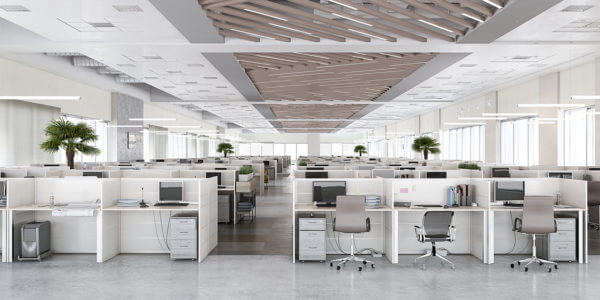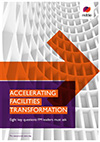The future of work: Where IT meets facilities management
As facilities management becomes increasingly tech-led, discover the role IT teams will play in creating the built environments of tomorrow.
We live in an age where data and digital technologies can help you to create exceptional working environments – those that boost the value of your brand, attract and retain talent, and improve the wellbeing and productivity of your employees.
But these benefits don’t just happen organically. They require the relationship between FM managers and IT professionals to become increasingly entwined.
In this blog, we’ll look at some of the ways IT teams can help facilitate and empower these improvements – and examine how you may see your role change in the coming years.
The great decarbonisation dichotomy
With the net zero deadline drawing closer, driving decarbonisation has fast become a priority for organisations in all industries – and for those with sprawling property portfolios, it can pose a major challenge.
In leading organisations, a variety of operational technologies are used to monitor energy use, identify new efficiencies, and reduce carbon emissions. And they all rely on one thing: your ability to gather, process, and analyse vast amounts of data.
Increasingly, IT departments will need to provide the support, platforms, and processing power required to do this – as well as the automated technologies and monitoring solutions needed to take action. But, IT isn’t just an enabler of decarbonisation. The department has a far more direct role to play.
In large organisations, data centres and IT supply chains can contribute greatly to a company’s carbon footprint. So, exploring solutions like cloud computing and readdressing how you procure technology can have an immediate and transformational impact on the pursuit of net zero.

Clearly, there’s something of a dichotomy here. IT can be an enabler of carbon reduction. (The World Economic Forum shows that digital technologies could deliver up to 20% of the reduction needed to meet net zero targets.) Yet at the same time, the digital solutions and technology required to enable change will further contribute to carbon emissions. The key, as with anything, is striking the right balance.
The onus is on IT departments to meet both challenges head on, and devise strategies that deliver the maximum benefit to the organisation as a whole.
Striking the balance between risk and opportunity
As data, digital technologies, and sensors play a growing role in all areas of FM, there will be numerous new opportunities to explore. But, with new opportunities come new risks.
The simple fact is, the operational technologies that enable new efficiencies in your built environment will inevitably increase your organisation’s threat landscape, and present new openings for cyberattacks.
For your IT department, this poses a challenge. The priority will always be ensuring the safety of your organisation’s sensitive data. But it’s imperative that you find a way to do so while being an enabler of change.
This means establishing robust, pre-emptive security policies to make sure what’s important remains protected. But also carefully vetting and authorising technologies and solutions so FM leaders still have the freedom to experiment and explore.
A recent report showed that two-thirds of managers consider the cybersecurity of operational technologies one of their most challenging responsibilities. Yet despite this awareness, only 44% currently have a cybersecurity solution in place to protect OT systems from an attack.
Clearly, security policies should be in place before solutions are deployed. So, this is an area that must be urgently addressed, and one that will inevitably play a big part in your future as further technologies are introduced.
Enabling hybrid working while avoiding office chaos
Initially a consequence of circumstance, hybrid working is now here to stay. And for the IT teams tasked with enabling seamless experiences between the office and home, there’s a great deal to consider.
It’s likely you’ve spent the last couple of years introducing tools and solutions needed to make collaborative work possible from anywhere. But how much attention has been paid to what happens back in the office – an environment that has become increasingly unpredictable in the way it’s populated and used?
Gathering data about how space is used and providing employees with real-time visibility into the availability of rooms can play a vital role in simplifying the chaos, removing friction, and keeping people productive.

And there’s an added benefit, too. With insight into how space is used, and the right supporting technologies, FM leaders can implement cost-saving measures, like automating or remotely controlling environments to turn off systems that aren’t required.
In the long-term, these insights can feed into wider strategic decisions around office space in general. It’s not uncommon to see organisations completely reassess their property portfolios when they’re able to see exactly what is being used and how.
Creating welcoming and inclusive spaces
That said, for many organisations, bringing people back to the office for at least a portion of their working week is a priority. And creating the environments that make people want to brave the commute – those that are flexible, convenient, and accommodating to the needs of different demographics – can not only improve employee wellbeing, but also help attract and retain new talent.
At the heart of this issue is the fact that different people will want different things. So, IT’s first role here is to help FM managers take a data-orientated, bottom-up approach to figuring out what employees want and mitigating any inherent biases that can affect office design.
Once it’s clear what’s needed, the next task is to implement the technologies required to create and optimise the desired office environment.
There are almost infinite ways of approaching this, from using occupancy sensors to optimise the use of space to introducing smart technologies that allow seamless office experiences, such as workplace apps. The approach you take will be entirely dependent on your people’s needs.
Get it right, and the impact of even the smallest changes can be huge. For instance, we recently worked with the IT team of a large financial institution to automate and improve office temperatures and reduced employee complaints related to workspace temperatures by 90%.
The next steps…
Facilities management optimisation is a continuous process, and one that will rely on the support of your team for the foreseeable future.
The key is not just putting the systems in place to generate data and insights, but also connecting that data to uncover new and exciting opportunities. And all of this has to be in line with an overall facilities management strategy.
Of course, developing the requisite capabilities takes time and investment. So, finding a partner who has already invested in these areas can be key.
As a tech-driven, managed-service provider with decades of experience, Mitie has invested significantly in the latest operational technologies, as well as leading security and monitoring solutions for the built environment. We regularly work with IT teams like yours to identify and implement the best approach to modernising facilities management.
If you’d like to discuss how we can help you become a hero to your FM teams, get in touch.
.
Download the white paper

Discover facilities transformation and download the free white paper today.